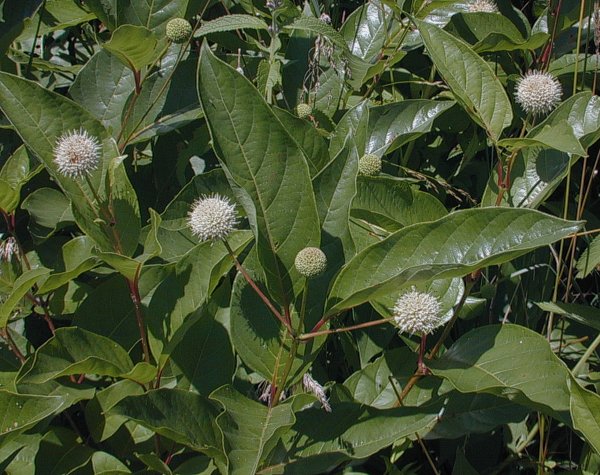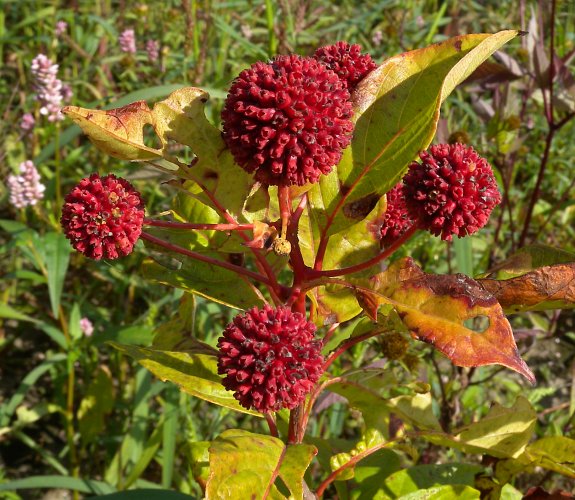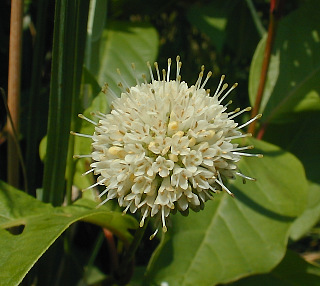Description: This woody shrub is usually 3-8' tall, but sometimes reaches 20' and achieves the stature of a small tree. It branches frequently and has a bushy appearance. The lower branches become woody and brown, while new growth is green or red. The leaves are usually opposite, although sometimes they occur in whorls of 3. They are up to 6" long and 2½" across, ovate or ovate-oblong in shape, and have slender petioles, smooth margins, and a glossy upper surface. In the typical variety of this species (described here), both the young branches and leaves are hairless, although there exists a less common variety of Buttonbush with pubescent branches and leaves.

From 1-3 spherical flowerheads occur on a flowering stalk that branches when more than a single flowerhead occurs. Some of the upper branches may terminate with these flowerheads, or a flowering stalk may occur from the axils of the leaves. Each mature flowerhead is about 1–1½" across, and is covered all around with small white or cream flowers. Each flower has a narrow corolla about 1/3" (8 mm.) long, with 4 small spreading lobes at its apex. There are 4 short stamens and a single white style that is quite long and undivided, projecting beyond the corolla. This latter characteristic provides the flowerhead with a starburst appearance. The small green calyx is tubular with 4 small teeth. It is about ¼" in length. The blooming period occurs during the summer (usually mid-summer) and lasts about 1 month. The flowers are sweetly fragrant. Afterwards, the flowerheads are replaced by spherical seedheads that turn red and eventually dark brown at maturity. Each flower is replaced by a small dry fruit that is narrowly obpyramidal (like a narrow upside-down pyramid). This fruit contains 2 cells, each cell containing a single seed (occasionally, one of the cells is empty). The root system is branching and woody.

Cultivation:
The preference is full or partial sun, wet to moist conditions, and a
fertile soil with high organic content. This shrub is semi-aquatic, and
can withstand flooded conditions for long periods of time. It will also
grow in soil that is consistently moist, rather than wet, but will be
smaller in size.
Range & Habitat:
The native Buttonbush occurs in most areas of Illinois, except for a
few counties
in the NW (see Distribution
Map). It is occasional to locally common. Habitats include
openings in floodplain forests, vernal pools in wooded areas, wet
thickets, shrubby swamps, wet
depressions in black soil prairies, marshes, bogs, seeps, seasonal
wetlands, and borders
of rivers and small lakes. This shrub can form extensive colonies at
some locations.
 Faunal
Associations:
The nectar and pollen of the flowers attract honeybees, bumblebees,
cuckoo bees (Triepeolus
spp.), long-horned bees (Melissodes spp.),
leaf-cutting bees (Megachile
spp.), green metallic bees (Agapostemon spp.),
various wasps, thick-headed flies (Conopidae), Syrphid flies,
butterflies, and skippers (Robertson, 1929). In addition, the
Ruby-throated Hummingbird sometimes visits the flowers for nectar
(Barnes, 1999). Other insects feed destructively on the leaves and
other parts of Buttonbush. These species include the Buttonbush Leaf
Beetle (Calligrapha
cephalanthi), a weevil (Plocetes ulmi),
larvae of the Buttonbush Gall Midge (Rabdophaga cephalanthi),
the Clouded Plant Bug (Neurocolpus
nubilus), larvae of a sawfly (Pseudosiobla excavata),
the Buttonbush Aphid (Aphis
cephalanthi), larvae of the Buttonbush Leafminer Moth (Mompha cephalanthiella),
and larvae of the Buttonbush Sphinx (Darapsa versicolor);
see Clark et al. (2004), Harms & Grodowitz (2009), Felt (1917),
Knight (1941), Smith (2006), Thomas (1877), Microleps website (2010),
and Wagner (2005). In addition, the Buttonbush Mite (Aceria cephalanthi)
forms clusters of small hairy galls on the leaves of this shrub. During
fall migration, ducks and other birds eat the seeds of Buttonbush (see
Bird Table); the
seeds are also eaten by these birds in southeastern
United States during the winter. Such birds as the Common Grackle and
King Rail occasionally use Buttonbush shrubs as nesting sites (DeVore
et al., 2004; Pearson, 1917/1936). Mammalian herbivores usually avoid
consumption of Buttonbush because it is poisonous. However, beavers use
the wood of this shrub either as a source of food or in the
construction of their dams and lodges (Martin et al., 1951/1961).
Faunal
Associations:
The nectar and pollen of the flowers attract honeybees, bumblebees,
cuckoo bees (Triepeolus
spp.), long-horned bees (Melissodes spp.),
leaf-cutting bees (Megachile
spp.), green metallic bees (Agapostemon spp.),
various wasps, thick-headed flies (Conopidae), Syrphid flies,
butterflies, and skippers (Robertson, 1929). In addition, the
Ruby-throated Hummingbird sometimes visits the flowers for nectar
(Barnes, 1999). Other insects feed destructively on the leaves and
other parts of Buttonbush. These species include the Buttonbush Leaf
Beetle (Calligrapha
cephalanthi), a weevil (Plocetes ulmi),
larvae of the Buttonbush Gall Midge (Rabdophaga cephalanthi),
the Clouded Plant Bug (Neurocolpus
nubilus), larvae of a sawfly (Pseudosiobla excavata),
the Buttonbush Aphid (Aphis
cephalanthi), larvae of the Buttonbush Leafminer Moth (Mompha cephalanthiella),
and larvae of the Buttonbush Sphinx (Darapsa versicolor);
see Clark et al. (2004), Harms & Grodowitz (2009), Felt (1917),
Knight (1941), Smith (2006), Thomas (1877), Microleps website (2010),
and Wagner (2005). In addition, the Buttonbush Mite (Aceria cephalanthi)
forms clusters of small hairy galls on the leaves of this shrub. During
fall migration, ducks and other birds eat the seeds of Buttonbush (see
Bird Table); the
seeds are also eaten by these birds in southeastern
United States during the winter. Such birds as the Common Grackle and
King Rail occasionally use Buttonbush shrubs as nesting sites (DeVore
et al., 2004; Pearson, 1917/1936). Mammalian herbivores usually avoid
consumption of Buttonbush because it is poisonous. However, beavers use
the wood of this shrub either as a source of food or in the
construction of their dams and lodges (Martin et al., 1951/1961).
Photographic Location:
A degraded seasonal wetland at Judge Webber Park in Urbana, Illinois.
This area is prone to occasional flooding after heavy rains.
Comments:
Buttonbush has attractive foliage and flowers. It is occasionally
planted as an ornamental shrub. Because of the unique flowerheads, it
is easy to identify in the field.